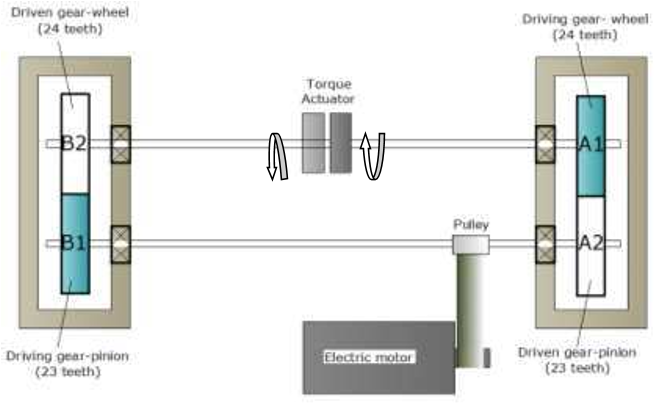Q2. What are the methods used to predict the initiation and propagation of gear micropitting?
Surface inspection procedures, such as surface roughness measurement, replica sample and digital image analysis, and profile scanning are used on the tested pinion gear to observe the micropitting development after each cycle run at certain torque level.
Q3. What is the principle of the back-to-back gear test rig?
The back-to-back gear test rig is designed based on a recirculating power loop principle, which provides a desired amount of fixed torque level through the tested gears, only consuming a small amount of power to drive them.
Q4. What is the torque actuator used in the gear test rig?
The torque actuator is used in the test rig to enable the torque to be applied gradually while the rig is running and to be maintained using a close electric/hydraulic loop control mechanism.
Q5. What is the process used to finish the gear tooth flanks?
The grinding machining process is used to finish the gear tooth flanks, with a specific geometry profile of linear tip relief and symmetrical lead crowning.
Q6. Why does gear failure contribute to costs?
It contributes to considerable costs due to early replacement of gears, unplanned shutdowns for carrying out maintenance procedures, such as for wind turbine gearboxes.
Q7. What is the effect of the micropitting on the gear teeth?
This can result in loss of transmission efficiency and increase the level of vibration, which further affects the gear tooth meshing accuracy and causes extra stress concentration on the micropitting area.
Q8. What is the effect of symmetrical lead crowning?
The effect of symmetrical lead crowning is ignored in the analysis because the calculation is considered only at the middle of the face width where the crowning has no effect.
Q9. What is the definition of a gear tooth flank?
Gear tooth flank micropitting is characterised by a continuous surface deterioration, owing to various operational and loading conditions.
Q10. What was the effect of the lubricant film thickness on the wear of the s?
Two torque levels were implemented in their tests and it was observed that the wear was lower for the shaved gears due to the effect of the lubricant film thickness.
Q11. Why is the micropitting occurring at the dedendum of the wheel?
The cause of this is that the micropitting is initiated at the dedendum of wheel where the grinding cutting edges exist due to the tooth profile tip relief, which meshes with the addendum of pinion thus causing the progressive micropitting in the addendum area of pinion.
Q12. How is the lubricant film thickness determined?
By applying the variable torque levels and constant rotational speed as used in the experiment and gear parameters as given in Tables 1 and 2, the contact stresses and lubricant film thicknesses can be determined.
Q13. What is the effect of the tip relief on the gears?
Owing to the elastic deformation of loaded teeth and high sliding at tooth tips, the tip relief extensions are equal for both gears.
Q14. How is the replica of the pinion produced?
The replica samples for the tooth surface of the tested pinion are produced by injecting a replication medium onto the tooth flank after each loading level.
Q15. What is the effect of the sliding motion on the gear teeth?
During gear engagement, gear teeth experience a complex combination of surface rolling and sliding contact which varies along the tooth flank [1-2], as shown in Figure 1.





